Alpha-1 Antitrypsin Reduces Disease Progression in a Mouse Model of Charcot-Marie-Tooth Type 1A: A Role for Decreased Inflammation and ADAM-17 Inhibition
Abstract
:1. Introduction
2. Results
2.1. Effects of Human Plasma Derived AAT (hAAT) in PMP22 Mice
2.1.1. Plasma hAAT Levels
2.1.2. Neuromuscular Tests
2.1.3. Sciatic Nerve Electrophysiology
2.1.4. Sciatic Nerve Histology
2.1.5. Plasma Cytokine Levels
2.2. AAT Inhibits Drivers of Dysmyelination and Inflammation In Vitro
2.2.1. AAT Inhibition of ADAM-17 Activity
2.2.2. AAT Reduces MHCII Activation in Inflammatory Cells
2.2.3. Transcriptomic Characterization of Inflammatory Cells Treated with AAT
3. Discussion
- Even if the CMT1A mouse model is a well-designed model that mimics many aspects of human disease, additional work with human material will be important. In particular, in vitro disease modeling using patient-derived stem cells could be an excellent approach for furthering our understanding of the mode of action of AAT in CMT1A [25]. As inflammation is difficult to model in vitro, mice with a humanized immune system might be an interesting alternative. As such, the CMT1A mutation would need to be introduced into NOD/SCID mice.
- The sample size of our animal studies was relatively small (n = 3). Nevertheless, hAAT significantly improved muscle action potential and histopathological features, and decreased circulating IL-6 in CMT1A mice; virtually all other parameters of disease severity showed a trend toward improvement. Thus, the effect of hAAT is strong and can be recognized even with a small sample size. However, additional in vivo studies are needed. Given the high potential for rapid clinical translation of hAAT therapy, such studies should be designed as part of a preclinical package.
- Our in vitro experiments provide initial clues to the molecular mechanism behind the protective effect of AAT. However, further studies will be needed for a more complete picture of the cascade of interactions involving AAT in CMT1A. We only investigated changes on the mRNA level. The importance of the proteasome and protein misfolding by impaired Schwann cells in demyelinating disease [26] suggests that additional proteomic research will be necessary to elucidate post-transcriptional mechanisms in CMT1A pathophysiology.
- The fine balance between the onset of inflammation and subsequent damage to the myelin sheath remains poorly understood and clearly needs further study. This is a promising direction for the discovery of novel therapeutic targets, in our opinion.
- Importantly, the therapeutic effect of AAT might not be limited to CMT1A alone, and could probably also be extended to other genetic, inflammatory, metabolic, or toxic neuropathies. For example, chronic inflammatory demyelinating polyneuropathy (CIDP) could also possibly be treated with hAAT, alone or in combination with immunoglobulin (IgG antibody) therapy.
4. Materials and Methods
4.1. Animals and Treatment
- Wild-type (WT) mice receiving vehicle, 0.9% NaCl (positive control)
- PMP22 mice receiving vehicle, 0.9% NaCl (negative control)
- PMP22 mice receiving hAAT (A9024 and A6510, Sigma-Aldrich) at 50 mg/kg per injection
4.2. Generation of Transgenic HMC3 Cells
4.3. Human Microglial Cell Line Culture
4.4. IFNγ-Mediated Human Microglia Activation
4.5. Exogenous/Endogenous AAT Treatment of IFNγ-Activated Human Microglia
4.6. Measurement of Human Microglia Cell Viability and Activation
4.7. RNA Collection and Sequencing, and Analysis of Differential Expression
4.8. Cell-Free ADAM-17 Activity
5. Patents
Supplementary Materials
Author Contributions
Funding
Institutional Review Board Statement
Informed Consent Statement
Data Availability Statement
Acknowledgments
Conflicts of Interest
References
- Goel, K.; Strange, C.; Sandhaus, R.A.; Petrache, I.; Serban, K.A. Updates in the Management of Alpha-1 Antitrypsin Deficiency Lung Disease. US Respir. Pulm. Dis. 2021, 6, 26. [Google Scholar] [CrossRef]
- Rahaghi, F.F. Alpha-1 antitrypsin deficiency research and emerging treatment strategies: What’s down the road? Ther. Adv. Chronic Dis. 2021, 12, 20406223211014025. [Google Scholar] [CrossRef]
- Fridman, V.; Reilly, M.M. Inherited Neuropathies. Semin. Neurol. 2015, 35, 407–423. [Google Scholar]
- Pisciotta, C.; Saveri, P.; Pareyson, D. Updated review of therapeutic strategies for Charcot-Marie-Tooth disease and related neuropathies. Expert Rev. Neurother. 2021, 21, 701–713. [Google Scholar] [CrossRef]
- Vital, A.; Vital, C.; Lagueny, A.; Ferrer, X.; Ribière-Bachelier, C.; Latour, P.; Petry, K.G. Inflammatory demyelination in a patient with CMT1A. Muscle Nerve 2003, 28, 373–376. [Google Scholar] [CrossRef]
- Williams, L.L.; Shannon, B.T.; Wright, F.S. Circulating cytotoxic immune components in dominant Charcot-Marie-Tooth syndrome. J. Clin. Immunol. 1993, 13, 389–396. [Google Scholar] [CrossRef]
- Bergin, D.A.; Reeves, E.P.; Meleady, P.; Henry, M.; McElvaney, O.J.; Carroll, T.P.; Condron, C.; Chotirmall, S.H.; Clynes, M.; O’Neill, S.J.; et al. α-1 Antitrypsin regulates human neutrophil chemotaxis induced by soluble immune complexes and IL-8. J. Clin. Investig. 2010, 120, 4236–4250. [Google Scholar] [CrossRef] [Green Version]
- van ‘t Wout, E.F.A.; Dickens, J.A.; van Schadewijk, A.; Haq, I.; Kwok, H.F.; Ordóñez, A.; Murphy, G.; Stolk, J.; Lomas, D.A.; Hiemstra, P.S.; et al. Increased ERK signalling promotes inflammatory signalling in primary airway epithelial cells expressing Z α1-antitrypsin. Hum. Mol. Genet. 2014, 23, 929–941. [Google Scholar] [CrossRef] [Green Version]
- Kobsar, I.; Hasenpusch-Theil, K.; Wessig, C.; Müller, H.W.; Martini, R. Evidence for macrophage-mediated myelin disruption in an animal model for Charcot-Marie-Tooth neuropathy type 1A. J. Neurosci. Res. 2005, 81, 857–864. [Google Scholar] [CrossRef]
- Wyss-Coray, T.; Mucke, L. Inflammation in Neurodegenerative Disease—A Double-Edged Sword. Neuron 2002, 35, 419–432. [Google Scholar] [CrossRef] [Green Version]
- Pott, G.B.; Chan, E.D.; Dinarello, C.A.; Shapiro, L. Alpha-1-antitrypsin is an endogenous inhibitor of proinflammatory cytokine production in whole blood. J. Leukoc. Biol. 2009, 85, 886–895. [Google Scholar] [CrossRef] [Green Version]
- Koulmanda, M.; Bhasin, M.; Hoffman, L.; Fan, Z.; Qipo, A.; Shi, H.; Bonner-Weir, S.; Putheti, P.; Degauque, N.; Libermann, T.A.; et al. Curative and beta cell regenerative effects of alpha1-antitrypsin treatment in autoimmune diabetic NOD mice. Proc. Natl. Acad. Sci. USA 2008, 105, 16242–16247. [Google Scholar] [CrossRef] [Green Version]
- Subramanian, S.; Shahaf, G.; Ozeri, E.; Miller, L.M.; Vandenbark, A.A.; Lewis, E.C.; Offner, H. Sustained expression of circulating human alpha-1 antitrypsin reduces inflammation, increases CD4+FoxP3+ Treg cell population and prevents signs of experimental autoimmune encephalomyelitis in mice. Metab. Brain Dis. 2011, 26, 107–113. [Google Scholar] [CrossRef]
- Mitroulis, I.; Skendros, P.; Ritis, K. Targeting IL-1beta in disease; the expanding role of NLRP3 inflammasome. Eur. J. Intern. Med. 2010, 21, 157–163. [Google Scholar] [CrossRef]
- Hetz, C.; Saxena, S. ER stress and the unfolded protein response in neurodegeneration. Nat. Rev. Neurol. 2017, 13, 477–491. [Google Scholar] [CrossRef]
- Okamoto, Y.; Pehlivan, D.; Wiszniewski, W.; Beck, C.R.; Snipes, G.J.; Lupski, J.R.; Khajavi, M. Curcumin facilitates a transitory cellular stress response in Trembler-J mice. Hum. Mol. Genet. 2013, 22, 4698–4705. [Google Scholar] [CrossRef] [Green Version]
- Zhang, B.; Lu, Y.; Campbell-Thompson, M.; Spencer, T.; Wasserfall, C.; Atkinson, M.; Song, S. Alpha1-antitrypsin protects beta-cells from apoptosis. Diabetes 2007, 56, 1316–1323. [Google Scholar] [CrossRef] [Green Version]
- Fortun, J.; Go, J.C.; Li, J.; Amici, S.A.; Dunn, W.A.; Notterpek, L. Alterations in degradative pathways and protein aggregation in a neuropathy model based on PMP22 overexpression. Neurobiol. Dis. 2006, 22, 153–164. [Google Scholar] [CrossRef]
- Lee, S.; Bazick, H.; Chittoor-Vinod, V.; Al Salihi, M.O.; Xia, G.; Notterpek, L. Elevated Peripheral Myelin Protein 22, Reduced Mitotic Potential, and Proteasome Impairment in Dermal Fibroblasts from Charcot-Marie-Tooth Disease Type 1A Patients. Am. J. Pathol. 2018, 188, 728–738. [Google Scholar] [CrossRef] [Green Version]
- Bai, Y.; Treins, C.; Volpi, V.G.; Scapin, C.; Ferri, C.; Mastrangelo, R.; Touvier, T.; Florio, F.; Bianchi, F.; Del Carro, U.; et al. Treatment with IFB-088 Improves Neuropathy in CMT1A and CMT1B Mice. Mol. Neurobiol. 2022; online ahead of print. [Google Scholar] [CrossRef]
- Stoll, G.; Gabreëls-Festen, A.A.; Jander, S.; Müller, H.W.; Hanemann, C.O. Major histocompatibility complex class II expression and macrophage responses in genetically proven Charcot-Marie-Tooth type 1 and hereditary neuropathy with liability to pressure palsies. Muscle Nerve 1998, 21, 1419–1427. [Google Scholar] [CrossRef]
- Harari, O.; Liao, J.K. Inhibition of MHC II gene transcription by nitric oxide and antioxidants. Curr. Pharm. Des. 2004, 10, 893–898. [Google Scholar] [CrossRef] [Green Version]
- Cellerini, M.; Salti, S.; Desideri, V.; Marconi, G. MR imaging of the cauda equina in hereditary motor sensory neuropathies: Correlations with sural nerve biopsy. Am. J. Neuroradiol. 2000, 21, 1793–1798. [Google Scholar]
- Morrow, J.M.; Evans, M.R.B.; Grider, T.; Sinclair, C.D.J.; Thedens, D.; Shah, S.; Yousry, T.A.; Hanna, M.G.; Nopoulos, P.; Thornton, J.S.; et al. Validation of MRC Centre MRI calf muscle fat fraction protocol as an outcome measure in CMT1A. Neurology 2018, 91, e1125–e1129. [Google Scholar] [CrossRef]
- Shi, L.; Huang, L.; He, R.; Huang, W.; Wang, H.; Lai, X.; Zou, Z.; Sun, J.; Ke, Q.; Zheng, M.; et al. Modeling the Pathogenesis of Charcot-Marie-Tooth Disease Type 1A Using Patient-Specific iPSCs. Stem Cell Rep. 2018, 10, 1–14. [Google Scholar] [CrossRef] [Green Version]
- Lee, S.M.; Chin, L.S.; Li, L. Protein misfolding and clearance in demyelinating peripheral neuropathies: Therapeutic implications. Commun. Integr. Biol. 2012, 5, 107–110. [Google Scholar] [CrossRef]
- Ma, H.; Lu, Y.; Li, H.; Campbell-Thompson, M.; Parker, M.; Wasserfall, C.; Haller, M.; Brantly, M.; Schatz, D.; Atkinson, M.; et al. Intradermal alpha1-antitrypsin therapy avoids fatal anaphylaxis, prevents type 1 diabetes and reverses hyperglycaemia in the NOD mouse model of the disease. Diabetologia 2010, 53, 2198–2204. [Google Scholar] [CrossRef] [Green Version]
- Baranovski, B.M.; Ozeri, E.; Shahaf, G.; Ochayon, D.E.; Schuster, R.; Bahar, N.; Kalay, N.; Cal, P.; Mizrahi, M.I.; Nisim, O.; et al. Exploration of α1-Antitrypsin Treatment Protocol for Islet Transplantation: Dosing Plan and Route of Administration. J. Pharmacol. Exp. Ther. 2016, 359, 482–490. [Google Scholar] [CrossRef] [Green Version]
- Li, B.; Bedard, K.; Sorce, S.; Hinz, B.; Dubois-Dauphin, M.; Krause, K.-H. NOX4 expression in human microglia leads to constitutive generation of reactive oxygen species and to constitutive IL-6 expression. J. Innate Immun. 2009, 1, 570–581. [Google Scholar] [CrossRef]
- Giry-Laterrière, M.; Verhoeyen, E.; Salmon, P. Lentiviral vectors. Methods Mol. Biol. 2011, 737, 183–209. [Google Scholar]

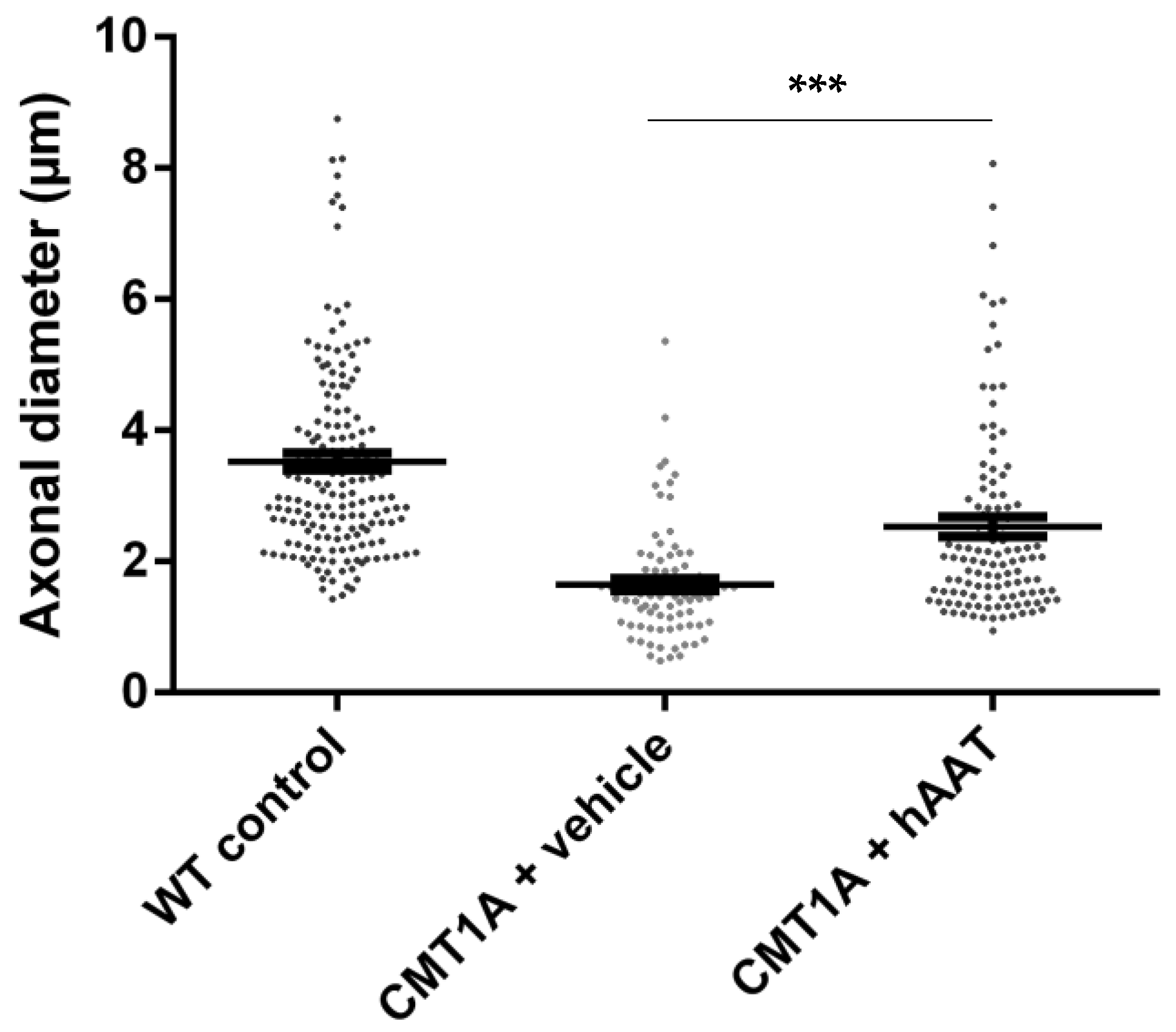
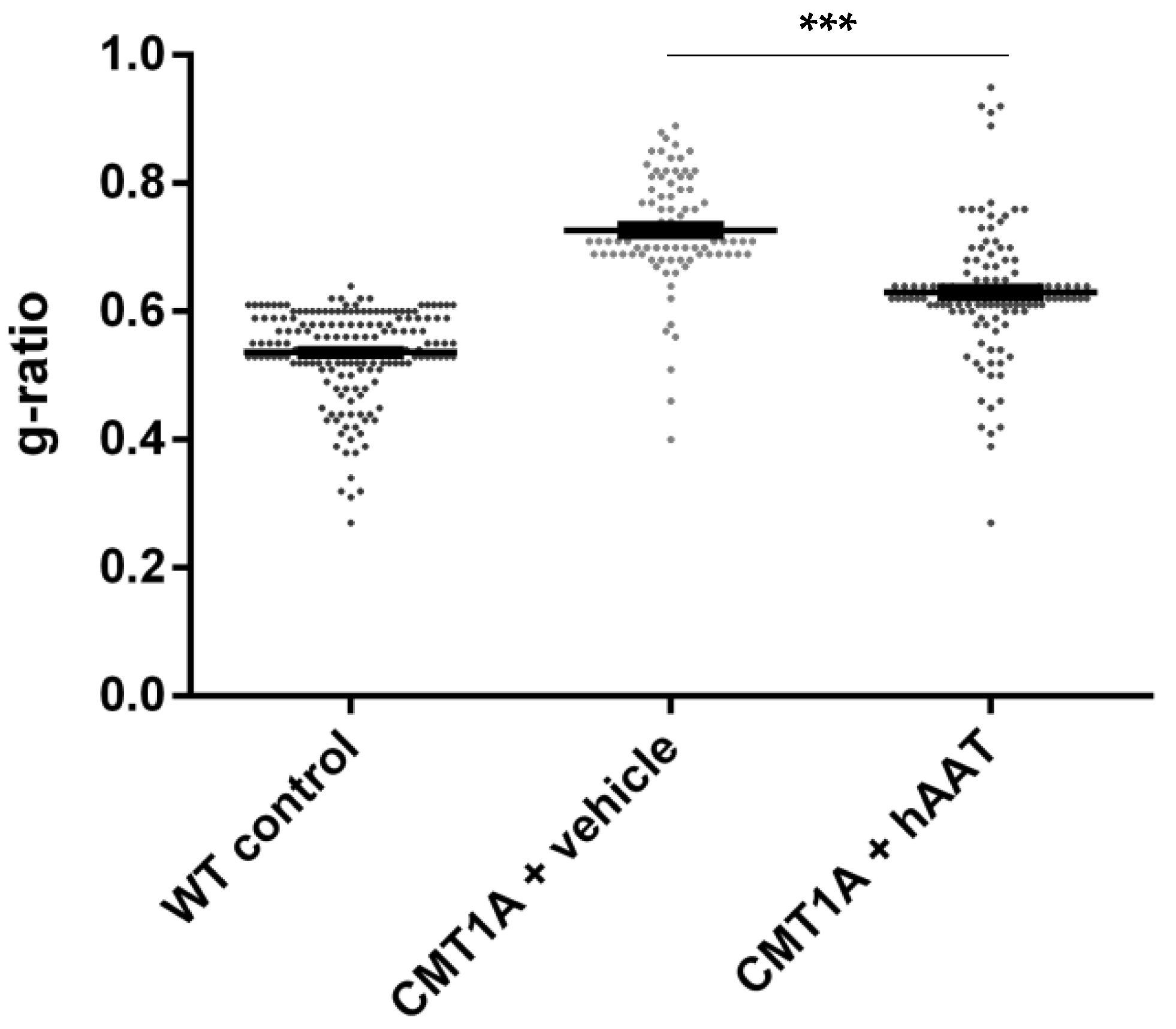

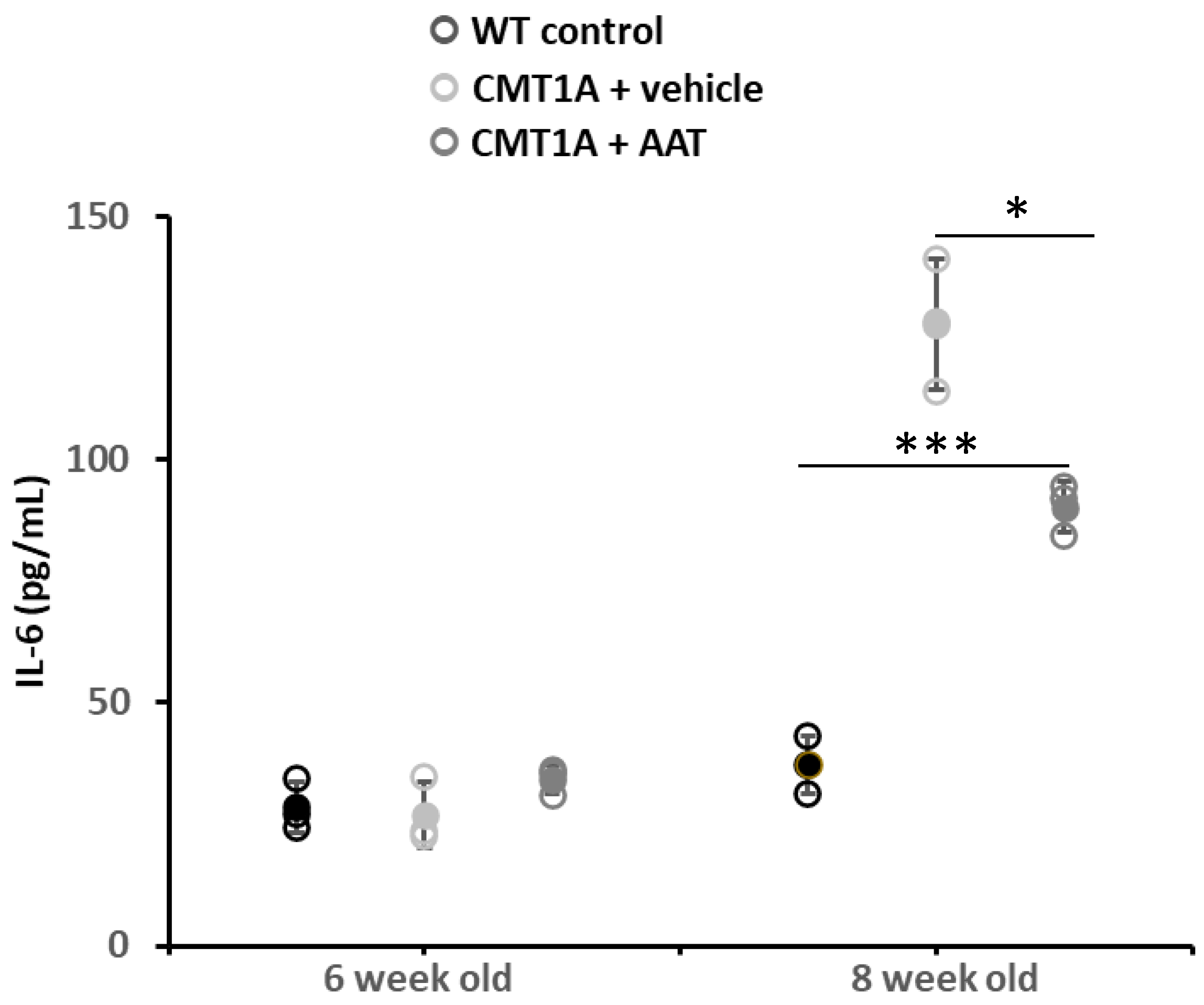
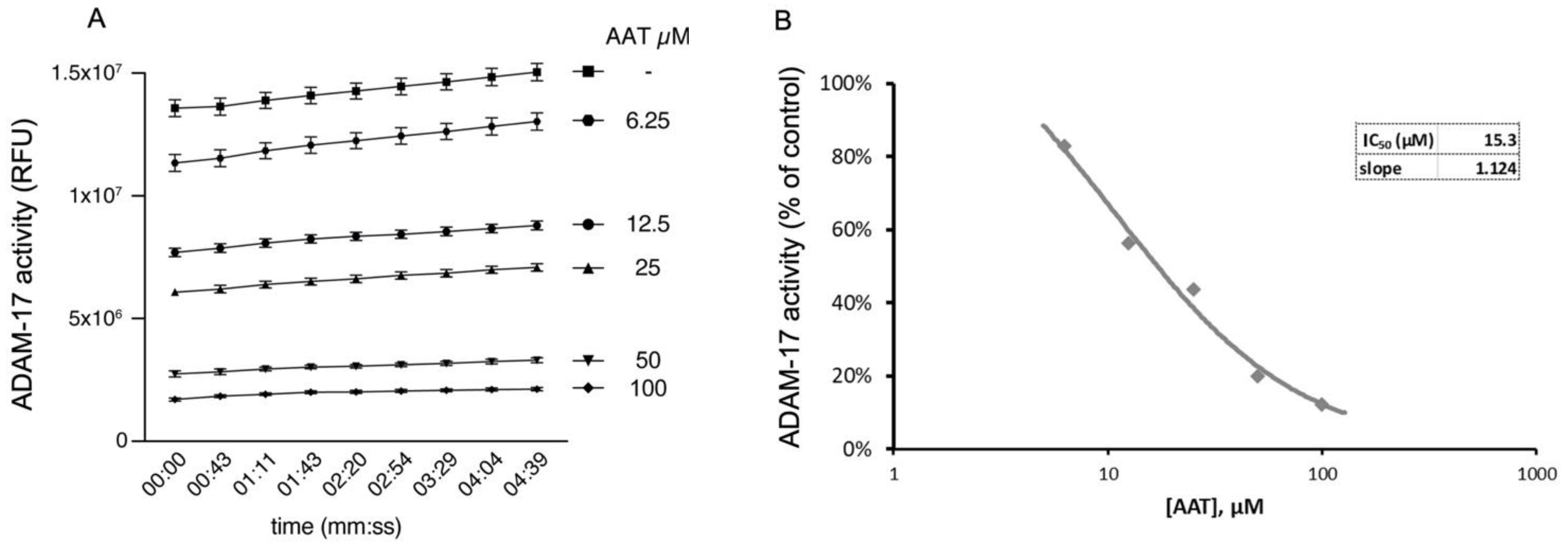
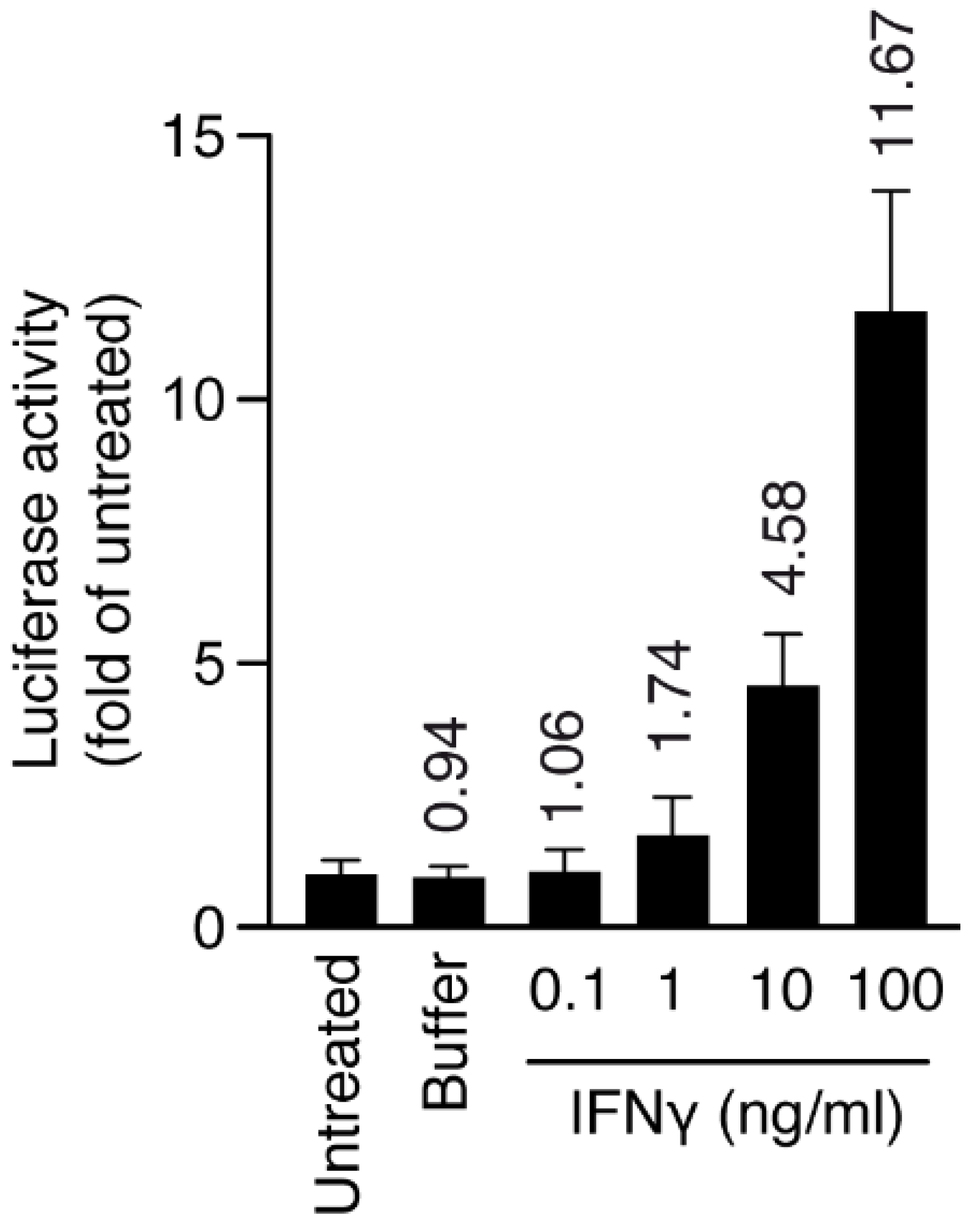
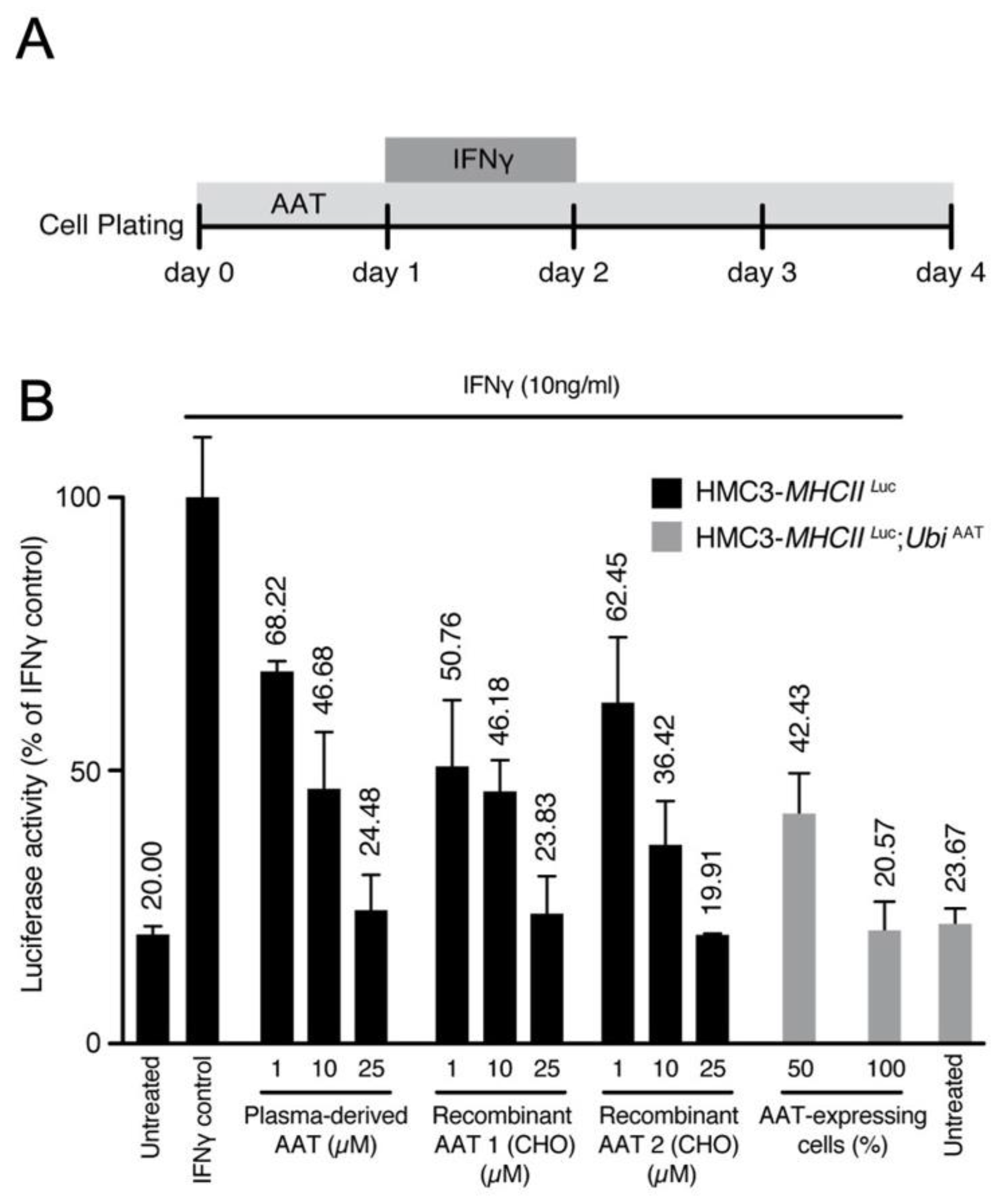
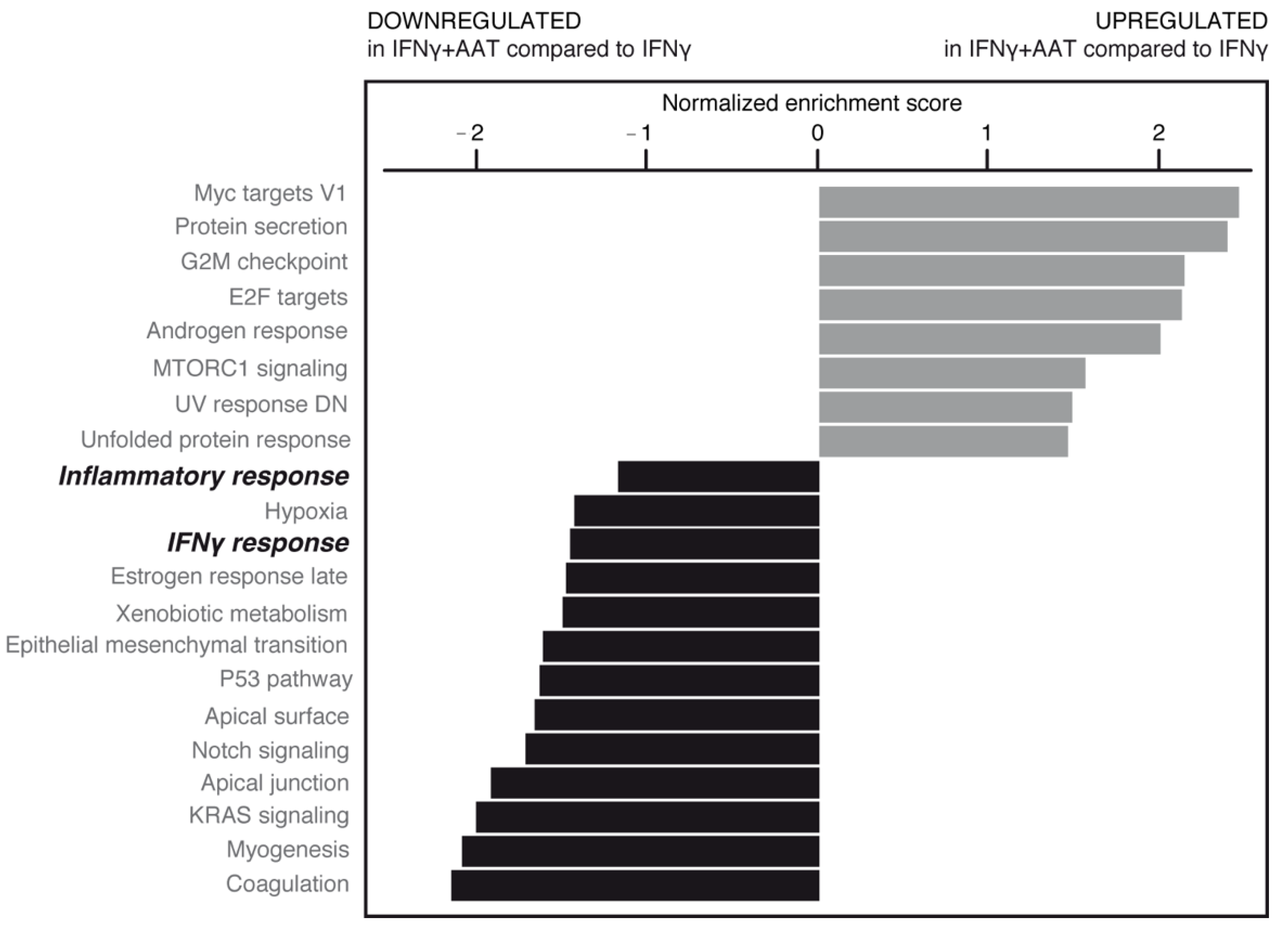

| CMAP (mV) | NCV (m/s) | |||
|---|---|---|---|---|
| 6 Weeks Old | 8 Weeks Old | 6 Weeks Old | 8 Weeks Old | |
| WT control | 7.67 ± 0.61 | 7.46 ± 0.73 | 32.03 ± 0.76 | 30.59 ± 2.73 |
| CMT1A + vehicle | 6.41 ± 0.32 | 2.89 ± 0.58 *** | 25.03 ± 1.42 | 12.68 ± 2.12 *** |
| CMT1A + AAT | 6.47 ± 0.30 | 5.63 ± 1.18 † | 24.91 ± 4.13 | 20.89 ± 1.63 * |
| Axons/100 µm2 | Axonal Diameter (µm) | G-Ratio | |
|---|---|---|---|
| WT control | 57.67 ± 0.88 | 3.52 ± 0.13 | 0.54 ± 0.005 |
| CMT1A + vehicle | 28.00 ± 7.02 * | 1.65 ± 0.09 *** | 0.73 ± 0.010 *** |
| CMT1A + AAT | 39.33 ± 4.81 | 2.53 ± 0.15 ††† *** | 0.63 ± 0.009 ††† *** |
| Day 1 | Day 8 | Day 14 | Day 29 | |
|---|---|---|---|---|
| WT control | 28.50 ± 3.04 | 29.74 ± 2.67 | 35.90 ± 4.516 | 37.20 ± 3.391 |
| CMT1A + vehicle | 26.90 ± 3.86 | 38.32 ± 4.78 | 85.04 ± 2.296 *** | 127.84 ± 7.810 *** |
| CMT1A + AAT | 34.19 ± 1.67 | 39.10 ± 1.91 * | 84.21 ± 4.727 ** | 90.20 ± 3.085 † *** |
| Top Gene | p-Value | FC | p-Value | FC |
|---|---|---|---|---|
| Up in inflammation | DOWN in inflammation + AAT | |||
| PSMB9 | 5.73 × 10−11 | 5.96 | 3.11× 10−2 | −1.23 |
| HLA-DOB | 5.11× 10−4 | 4.48 | 6.82× 10−3 | −4.49 |
| HLA-DRA | 4.99× 10−10 | 4.76 | 4.68× 10−2 | −2.22 |
| IL1B | 5.54× 10−4 | 2.08 | 1.11× 10−3 | −2.07 |
| DOWN in inflammation | UP in inflammation + AAT | |||
| CALR | 6.15× 10−11 | −3.53 | 4.74× 10−4 | 1.35 |
| PYCARD | 6.92× 10−3 | −2.86 | 1.53× 10−2 | 2.20 |
| Top Gene | p-Value | FC | p-Value | FC |
|---|---|---|---|---|
| UP in inflammation | DOWN in inflammation + AAT | |||
| ATF3 | 6.86× 10−13 | 7.218 | 1.85× 10−3 | −1.26 |
| PSMB9 | 6.09× 10−10 | 5.963 | 3.11× 10−2 | −1.23 |
| FGF2 | 1.66× 10−6 | 3.608 | 9.13× 10−3 | −1.57 |
| CXCL1 | 1.36× 10−4 | 2.82 | 7.22× 10−3 | −2.09 |
| TNFRSF9 | 2.39× 10−4 | 2.434 | 1.23× 10−3 | −2.35 |
| CXCL5 | 5.07× 10−5 | 2.36 | 5.98× 10−3 | −2.15 |
| IL1B | 2.14× 10−3 | 2.08 | 1.11× 10−3 | −2.07 |
| DOWN in inflammation | UP in inflammation + AAT | |||
| FSCN1 | 9.42× 10−8 | −6.312 | 8.09× 10−4 | 1.48 |
| IL4I1 | 3.22× 10−3 | −4.19 | 3.22× 10−3 | 1.95 |
| IL27RA | 2.22× 10−7 | −3.848 | 2.67× 10−2 | 1.36 |
| STAT5A | 7.66× 10−4 | −3.53 | 9.78× 10−3 | 1.45 |
| IL1R1 | 1.27× 10−7 | −2.566 | 3.94× 10−2 | 1.18 |
| JAK3 | 3.03× 10−8 | −2.43 | 3.20× 10−3 | 1.43 |
| RASAL1 | 1.36× 10−6 | −2.34 | 4.65× 10−3 | 1.52 |
Publisher’s Note: MDPI stays neutral with regard to jurisdictional claims in published maps and institutional affiliations. |
© 2022 by the authors. Licensee MDPI, Basel, Switzerland. This article is an open access article distributed under the terms and conditions of the Creative Commons Attribution (CC BY) license (https://creativecommons.org/licenses/by/4.0/).
Share and Cite
Zhukovsky, N.; Silvano, M.; Filloux, T.; Gonzalez, S.; Krause, K.-H. Alpha-1 Antitrypsin Reduces Disease Progression in a Mouse Model of Charcot-Marie-Tooth Type 1A: A Role for Decreased Inflammation and ADAM-17 Inhibition. Int. J. Mol. Sci. 2022, 23, 7405. https://doi.org/10.3390/ijms23137405
Zhukovsky N, Silvano M, Filloux T, Gonzalez S, Krause K-H. Alpha-1 Antitrypsin Reduces Disease Progression in a Mouse Model of Charcot-Marie-Tooth Type 1A: A Role for Decreased Inflammation and ADAM-17 Inhibition. International Journal of Molecular Sciences. 2022; 23(13):7405. https://doi.org/10.3390/ijms23137405
Chicago/Turabian StyleZhukovsky, Nikolay, Marianna Silvano, Thierry Filloux, Sergio Gonzalez, and Karl-Heinz Krause. 2022. "Alpha-1 Antitrypsin Reduces Disease Progression in a Mouse Model of Charcot-Marie-Tooth Type 1A: A Role for Decreased Inflammation and ADAM-17 Inhibition" International Journal of Molecular Sciences 23, no. 13: 7405. https://doi.org/10.3390/ijms23137405
APA StyleZhukovsky, N., Silvano, M., Filloux, T., Gonzalez, S., & Krause, K.-H. (2022). Alpha-1 Antitrypsin Reduces Disease Progression in a Mouse Model of Charcot-Marie-Tooth Type 1A: A Role for Decreased Inflammation and ADAM-17 Inhibition. International Journal of Molecular Sciences, 23(13), 7405. https://doi.org/10.3390/ijms23137405






